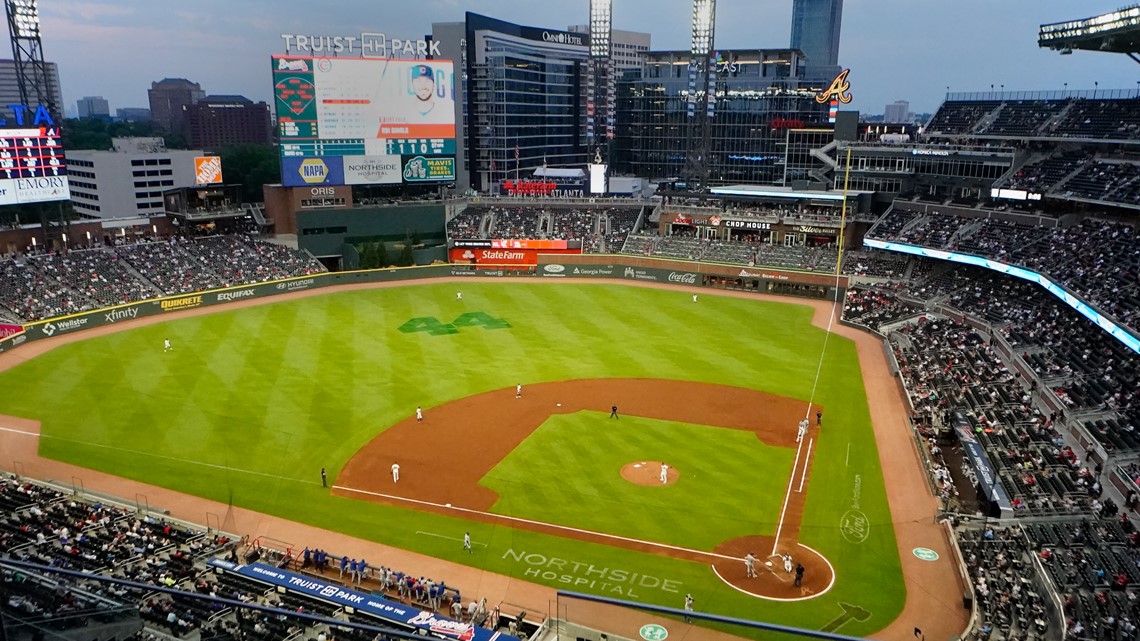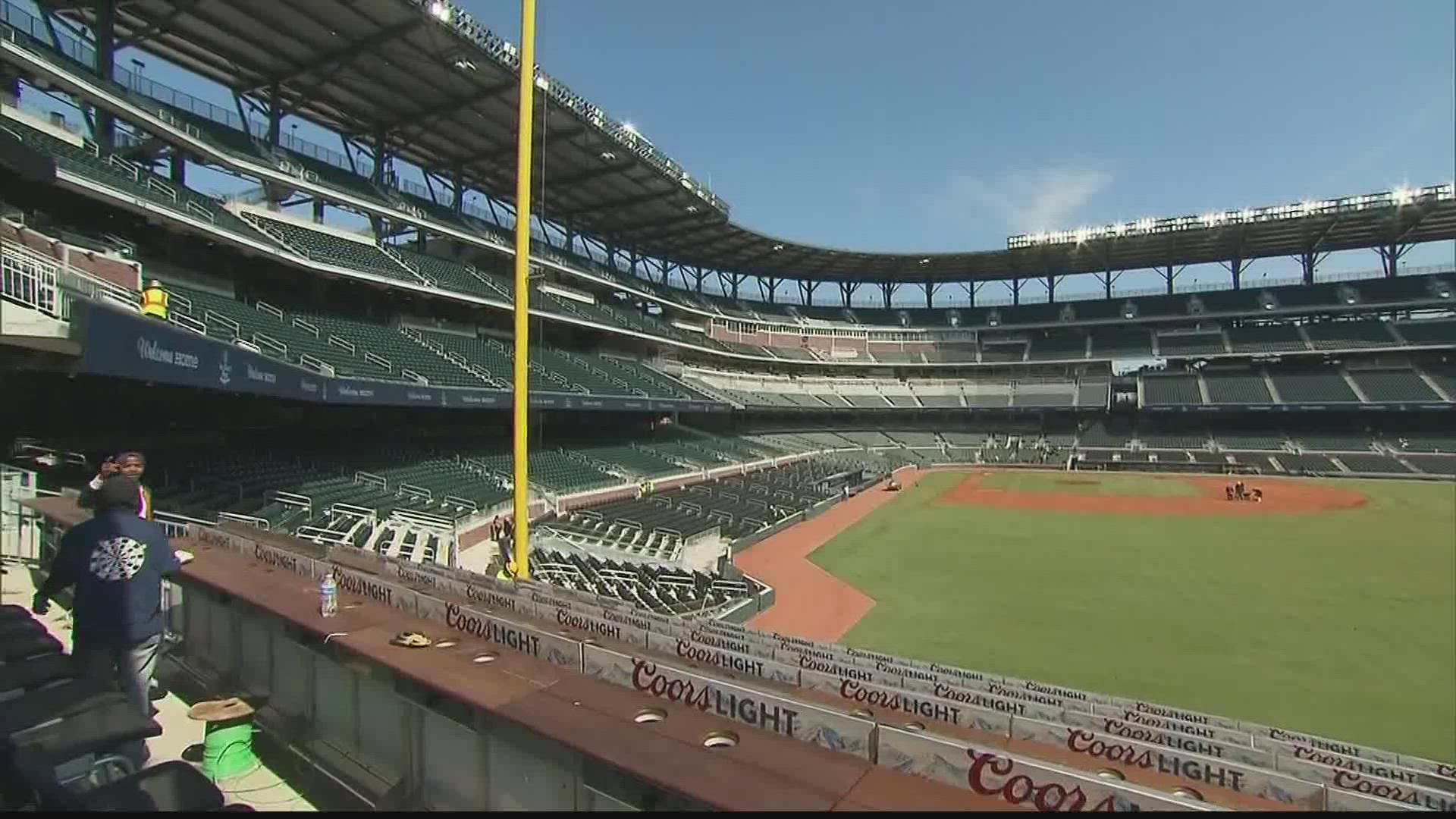COBB COUNTY, Ga. — The image back in November of the Atlanta Braves parading down Cobb Parkway as World Series champions is the kind of thing, some might say, you can't put a price on.
But, if you could, according to a new report it would come to about $50 a year for every household in Cobb County.
The report, by Kennesaw State professor and economist J.C. Bradbury, deconstructs the argument - originally made about a decade ago to justify the stadium project in Cobb County - that the Braves deal would not only pay for itself, but become a fountain of new revenue and economic development in the county.
The reality, five years after Cobb became "home of the Braves," is a bit more mundane - Truist Park's economic impact tracks with the long-established, underwhelming record of public investments in sports stadiums.
Bradbury has long been a critic of the original stadium deal, which called for the county to provide $300 million toward the construction of the ballpark.
A county spokesperson, responding to an 11Alive inquiry, said they were "well-aware of Mr. Bradbury's long-running thesis and do not expect him to change his tune" and that it was "unfortunate he decided to crunch numbers following more than two years of a pandemic which greatly impacted so many sectors of the community."
Bradbury told 11Alive he's not trying to rain on the Braves' parade - he's a fan himself, and he concludes in his study that the findings "do not mean that my fellow Cobb residents should not enjoy baseball and cheer on the local team: I still do."
But alongside highly technical economic analyses within the report is some of the simplest evidence for Bradbury's case, regardless of the pandemic. Growth in Cobb County's sales tax revenues and property values, benchmarks that the stadium was supposed to balloon, have not outperformed neighboring counties in metro Atlanta.
A portion of the study, on page 48, compares sales tax revenue per capita in Cobb and other metro Atlanta counties after the opening of Truist Park in 2017, and finds "Cobb’s growth was less than the rest of Atlanta, which is not consistent with the stadium stimulating additional economic activity in Cobb."
On page 56, Bradbury compares property values inside the Cumberland Community Improvement District (CID) - a specially designated development zone created around the stadium by the county - to other Community Improvement Districts in neighboring counties.


The data, according to the study, shows that property value growth in the Cumberland zone - even with the benefit of the new stadium - "appears typical among local CIDS" in Fulton, Gwinnett and DeKalb, "which is not indicative of extraordinary growth from the stadium."
And a few pages later, the study examines general property value growth in the county - which has grown considerably. But, as anyone familiar with the current housing market knows, that's the case in many places.
The study finds no additional benefit coming from the stadium, given that, "Cobb property value growth since 2013 has been typical among area counties, including Atlanta’s prosperous core of DeKalb, Gwinnett, and Fulton."
Bradbury told 11Alive that "if there was some growth or economic benefits that were stimulated by the stadium, we should see a deviation from Cobb and the CID from other parts of Atlanta, and that's something that I couldn't find."
He also applied more complex economic modeling methods to see if "hey, maybe there's something I'm missing here," but the results remained broadly the same.
"I still couldn't find any different - that pretty much the growth in and around the stadium and in Cobb is pretty similar to the rest of Atlanta, nothing unique," Bradbury said.
The reason for this is that, generally speaking, stadiums tend not to generate economic activity that wouldn't happen anyway. The report describes the "crowding out" effect of business activity by Cobb County residents that may otherwise go to, say, downtown Kennesaw or Marietta Square, instead going to The Battery.
As for spending coming from people who aren't already Cobb residents, a lot of that falls into buckets of economic activity that would have happened all the same, just now instead at a Braves game. Bradbury terms those as "casuals" and "time-switchers."
"Casuals are attendees who happened to be visiting Cobb and decided to attend a game because it was an option. For example, a business traveler staying overnight in Cobb decides to attend a game instead of going out to dinner. Time-switchers plan their visits to town when games are occurring. For example, grandparents plan to visit their grandchildren in Cobb during baseball season rather than at Thanksgiving," the study explains.
Backers of the original deal argued the addition of The Battery and the stadium's position near major interstates, where it could easily capture business from non-Cobb fans, made it uniquely positioned to buck the historical trends with public investments in stadiums.
Instead, the numbers generally don't bear that out. The study says servicing the stadium debt and funding certain operations around the ballpark have outpaced the income of stadium-related tax revenues, "costing taxpayers nearly $15 million per year."
That works out, according to Bradbury, at about $50 per household.
Bradbury's analysis incorporates the Cumberland Special District tax, which raises revenue from a specially designated area around the stadium, as a cost to the county - rather than functionally "free" revenue that wouldn't otherwise be captured without the stadium, as other, more optimistic studies on the economic impact have done.
He argues that "special district taxes represent a real burden to Cobb taxpayers to fund the stadium, which amounts to nearly $9 million in tax revenues annually that must be subtracted from the fiscal benefit calculus."
But even leaving that out, the report notes, the county contributes $6.4 million out of its general fund every year toward paying off the debt incurred to fund the stadium, a cost of $23 per household. That's because the level of hoped-for new revenues aren't bringing "that $6.4 million down to zero so the citizens are not paying anything to the stadium," as former Cobb District 2 Commissioner Bob Ott once projected.
Bradbury said that, as a Braves fan, it was one thing to use public money to build something nice and fun that people enjoy with the full understanding that it mostly doesn't bring back a return.
It's just that, as an economist, he wants to make clear the premise of the original deal - that it was an investment that would pay for itself and then some with growth and new tax revenues - is faulty.
"I like to tell this old joke – what’s the difference between a burglar and a politician? A burglar comes to your house and takes your stuff and leaves - a politician comes, takes your stuff and tells you why it's good for you," he said. "If we wanna build a stadium, wanna spend tax dollars on it like we spend on libraries and parks and say it’s a worthwhile expenditure, I'm all for that, do that."
But, he added: "Don’t tell me you're making me rich, because that’s not the case, and if it was the case it should be obvious for us to see."

